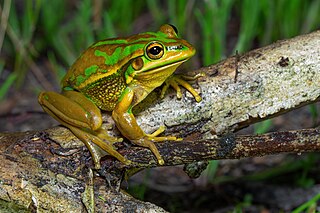
The green and golden bell frog, also named the green bell frog, green and golden swamp frog and green frog, is a species of ground-dwelling tree frog native to eastern Australia. Despite its classification and climbing abilities, it does not live in trees and spends almost all of its time close to ground level. It can reach up to 11 cm (4.5 in) in length, making it one of Australia's largest frogs.

Eravikulam National Park is a 97 km2 national park located along the Western Ghats in the Idukki and Ernakulam districts of Kerala in India. The park is situated between 10º05'N and 10º20' north, and 77º0' and 77º10' east and is the first national park in Kerala. It was established in 1978.

Geocrinia is a genus of frogs in the family Myobatrachidae. These frogs are endemic to Australia. Two species are known from southeastern Australia, while one is known from southeastern Western Australia.
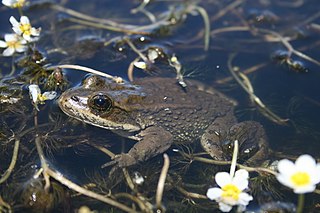
The Columbia spotted frog is a North American species of frog. It is green to brown in color with spots on the dorsal surface. The belly and upper lip are white in color. Individuals can be distinguished from other Rana species by their shorter back legs, narrow snout, and upturned eyes. Since they spend most of their time in the water, they also have more webbing in their hind feet than similar species. Although not threatened, this animal has been studied as a model species for the effects of habitat fragmentation.
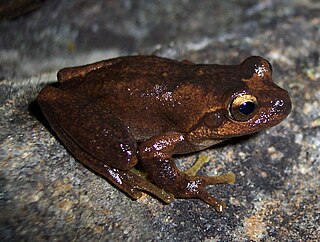
Littlejohn's tree frog, also called a heath frog or orange-bellied tree frog, is a species of tree frog native to eastern Australia from Wyong, New South Wales, to Buchan, Victoria.

Amphibians of Australia are limited to members of the order Anura, commonly known as frogs. All Australian frogs are in the suborder Neobatrachia, also known as the modern frogs, which make up the largest proportion of extant frog species. About 230 of the 5,280 species of frog are native to Australia with 93% of them endemic. Compared with other continents, species diversity is low, and may be related to the climate of most of the Australian continent. There are two known invasive amphibians, the cane toad and the smooth newt.

The long-thumbed frog, Fletcher's frog or barking marsh frog is a species of non-burrowing ground frog native to south-eastern Australia. The species belongs to the genus Limnodynastes. The twelve species in the genus are characterised by a lack of toe pads. Following phylogenetic analysis, the species was placed in L. peronii clade group alongside L. depressus, L.tasmaniensis and L. peronii.

Warren, also known as Karri Forest Region and the Jarrah-Karri forest and shrublands ecoregion, is a biogeographic region in southern Western Australia. Located in the southwest corner of Western Australia between Cape Naturaliste and Albany, it is bordered to the north and east by the Jarrah Forest region. Its defining characteristic is an extensive tall forest of Eucalyptus diversicolor (karri). This occurs on dissected, hilly ground, with a moderately wet climate. Karri is a valuable timber and much of the karri forest has been logged over, but less than a third has been cleared for agriculture. Recognised as a region under the Interim Biogeographic Regionalisation for Australia (IBRA), and as a terrestrial ecoregion by the World Wide Fund for Nature, it was first defined by Ludwig Diels in 1906.
Anstisia vitellina, commonly known as the orange-bellied frog, is a species of frog in the family Myobatrachidae. It is endemic to a 20 hectare area near Margaret River in Southwest Australia. It is vulnerable to extinction due to fire and the destruction of habitat caused by feral pigs.
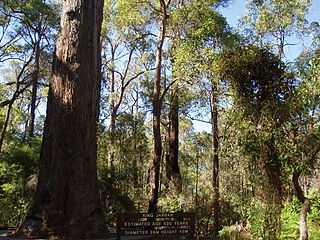
Jarrah Forest, also known as the Southwest Australia woodlands, is an interim Australian bioregion and ecoregion located in the south west of Western Australia. The name of the bioregion refers to the region's dominant plant community, jarrah forest – a tall, open forest in which the dominant overstory tree is jarrah.

Geocrinia laevis, the smooth frog, southern smooth froglet, smooth froglet, or Tasmanian smooth frog, is a species of frog in the family Myobatrachidae. It is endemic to Australia and found in Tasmania, southwestern Victoria, and the extreme southeast of South Australia.
Anstisia lutea is a species of frog in the family Myobatrachidae. It is sometimes named for the nearby towns, thus the Nornalup or Walpole frog. It is endemic to Southwest Australia, along with the other members of the genus Anstisia. It was formerly classified in the genus Geocrinia, but was reclassified into the new genus Anstisia in 2022.
Anstisia rosea, the karri or roseate frog is a species in the family, Myobatrachidae. It is endemic to Southwest Australia.

The micro frog, or Cape Flats frog, is a species of frog less than 2 cm (0.8 in) long in the family Pyxicephalidae, in the monotypic genus Microbatrachella. Its color varies from rufous brown with dark mottling, to tan or green, depending on the population. It is endemic to the south-western Cape area of South Africa, with a single population found on the Cape Flats of Cape Town and several populations on the eastern side of False Bay. It typically lives in wetlands in coastal fynbos habitats, but its total area of occupancy is very small, and the International Union for Conservation of Nature has rated it as being "critically endangered".
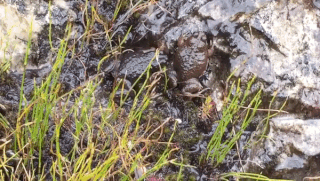
Poyntonia, is a monotypic frog genus in the family Pyxicephalidae. It was named after J.C. Poynton, a notable herpetologist who worked in southern Africa.
The Amphibians of Western Australia are represented by two families of frogs. Of the 78 species found, most within the southwest, 38 are unique to the state. 15 of the 30 genera of Australian frogs occur; from arid regions and coastlines to permanent wetlands.
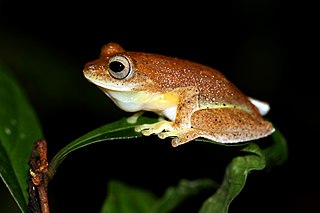
Mercurana is a genus of arboreal frogs belonging to the family Rhacophoridae. The genus was named from the only known species Mercurana myristicapalustris, which was described in 2013 from the Western Ghats of Kerala, India. The generic name was derived from and given as a tribute to Freddie Mercury, the late vocalist of the British rock band Queen, in combination with the Latin name for "frog". The frog is different from other related frogs in that it has extensively webbed toes, lives only in swampy lowlands, and lays its eggs on mud with which it carefully mixes leaf litter.
Marion Anstis is an Australian herpetologist. Her work focuses on frogs and Tadpoles found in Australia.
Anstisia is a genus of frogs in the family Myobatrachidae. These frogs are endemic to southern Western Australia.












